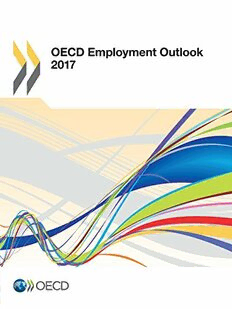
OECD Employment Outlook 2017 PDF
Preview OECD Employment Outlook 2017
OECD Employment Outlook 2017 O E C D E m p lo y m e n t O u t lo o k 2 0 1 7 OECD Employment Outlook 2017 ThisworkispublishedundertheresponsibilityoftheSecretary-GeneraloftheOECD.The opinionsexpressedandargumentsemployedhereindonotnecessarilyreflecttheofficial viewsofOECDmembercountries. This document and any map included herein are without prejudice to the status of or sovereigntyoveranyterritory,tothedelimitationofinternationalfrontiersandboundaries andtothenameofanyterritory,cityorarea. Pleasecitethispublicationas: OECD(2017),OECDEmploymentOutlook2017,OECDPublishing,Paris. http://dx.doi.org/10.1787/empl_outlook-2017-en ISBN978-92-64-27485-3(print) ISBN978-92-64-27486-0(PDF) ISBN978-92-64-27487-7(epub) Series:OECDEmploymentOutlook ISSN1013-0241(print) ISSN1999-1266(online) ThestatisticaldataforIsraelaresuppliedbyandundertheresponsibilityofthe relevantIsraeliauthorities.Theuse ofsuchdatabytheOECDiswithoutprejudicetothestatusoftheGolanHeights,EastJerusalemandIsraeli settlementsintheWestBankunderthetermsofinternationallaw. Photocredits:Cover©Ikoneimages/Inmagine. CorrigendatoOECDpublicationsmaybefoundonlineat:www.oecd.org/about/publishing/corrigenda.htm. ©OECD2017 Youcancopy,downloadorprintOECDcontentforyourownuse,andyoucanincludeexcerptsfromOECDpublications,databasesand multimediaproductsinyourowndocuments,presentations,blogs,websitesandteachingmaterials,providedthatsuitable acknowledgmentofthesourceandcopyrightownerisgiven.Allrequestsforpublicorcommercialuseandtranslationrightsshouldbe submittedtorights@oecd.org.Requestsforpermissiontophotocopyportionsofthismaterialforpublicorcommercialuseshallbe addresseddirectlytotheCopyrightClearanceCenter(CCC)[email protected]çaisd’exploitationdudroitdecopie (CFC)[email protected]. FOREWORD Foreword T he OECD Employment Outlook provides an annual assessment of key labour market developmentsandprospectsinOECDmembercountries.Eacheditionalsocontainsseveralchapters focusingonspecificaspectsofhowlabourmarketsfunctionandtheimplicationsforpolicyinorder to promote more and better jobs. This year’s chapters cover a comparison of labour market performanceindifferentcountriesintermsofthequantityandqualityofjobandinclusiveness,the policydeterminantsoflabourmarketresiliencefollowingthe2008economiccrisis,anassessmentof how technology and globalisation are transforming the labour market, and a rich description of collectivebargaininginOECDcountries. The 2017 OECD Employment Outlook is the joint work of staff of the Directorate for Employment, Labour and Social Affairs. The staff of the OECD Economics Department also contributedtothepreparationofChapter2.Ithasgreatlybenefitedfromcontributionsfromnational government delegates. However, the Outlook’s assessments of each country’s labour market prospectsdonotnecessarilycorrespondtothosemadebythenationalauthoritiesconcerned. ThisreportwaseditedbyPaulSwaim,andisbasedoncontributionsfromAndreaBassanini, Pascal Marianna and Paul Swaim (Chapter1),Alexander Hijzen,Andreas Kappeler, Mathilde Pak andCyrilleSchwellnus(Chapter2),PaoloFalcoandAndreaSalvatori(Chapter3),andSandrineCazes andAndreaGarnero(Chapter4).ResearchassistancewasprovidedbyDanaBlumin,SylvieCimper, DuncanMacDonald,SébastienMartinandAgnèsPuymoyen.Editorialassistancewasprovidedby GabrielaBejan,NatalieCorry,MonicaMeza-EssidandMarlèneMohier. OECDEMPLOYMENTOUTLOOK2017©OECD2017 3 TABLEOFCONTENTS Table of contents Editorial.Thebacklashagainstglobalisation:Whatdoesitmeanforemployment policy? .................................................................... 9 Acronymsandabbreviations................................................. 15 Executivesummary......................................................... 17 Chapter1.Howarewedoing?Abroadassessmentoflabourmarketperformance.. 19 Keyfindings............................................................ 20 Introduction............................................................ 21 1.Currentlabourmarketconditionsandtheshort-termoutlook............... 22 2.Towardsabroadassessmentoflabourmarketperformance ................ 23 3.Thequantityandqualityofemployment................................. 25 4.Labourmarketinclusiveness ........................................... 28 5.Ascoreboardoflabourmarketperformanceintermsofjobquantity, jobqualityandinclusiveness............................................. 36 Conclusions............................................................ 42 Notes.................................................................. 42 References ............................................................. 45 Chapter2.Labourmarketresilience:Theroleofstructuralandmacroeconomic policies................................................................ 47 Keyfindings............................................................ 48 Introduction............................................................ 50 1.ResilienceinthewakeoftheGreatRecession............................. 50 2.Thepolicydeterminantsoflabourmarketresilience....................... 58 3.Theeffectsoflabourmarketandfiscalpoliciesforlabourmarketresilience followingtheGreatRecession............................................. 69 Conclusions............................................................ 74 Notes.................................................................. 75 References ............................................................. 77 Chapter3.Howtechnologyandglobalisationaretransformingthelabourmarket .. 81 Keyfindings............................................................ 82 Introduction............................................................ 84 1.Thechangingstructureofthelabourmarket.............................. 85 2.Estimatingtheeffectsoftechnologyandglobalisationonthelabourmarket .. 94 3.Policyoptionstohelpworkerswithstandlabourmarkettransformations..... 108 Conclusions............................................................ 113 Notes.................................................................. 114 References ............................................................. 116 OECDEMPLOYMENTOUTLOOK2017©OECD2017 5 TABLEOFCONTENTS Annex3.A1.Additionalevidenceonpolarisation................................. 120 Annex3.A2.Estimatesonselectedcountries,2000-15............................. 123 Chapter4.Collectivebargaininginachangingworldofwork..................... 125 Keyfindings............................................................ 126 Introduction............................................................ 128 1.Thefunctionsandthefeaturesofcollectivebargaining..................... 129 2.Theactorsandthescopeofcollectivebargaining.......................... 132 3.Unpackingthecomplexmachineryofcollectivebargaining................. 146 4.Howdonationalcollectivebargainingsystemscompare?................... 163 Conclusions............................................................ 165 Notes.................................................................. 167 References ............................................................. 168 Glossary ................................................................... 172 Annex4.A1.Furthermaterial.................................................. 174 Statisticalannex............................................................ 187 Tables 1.1. TheframeworkforthenewOECDJobsStrategy.......................... 24 1.2. Labourmarketperformancescoreboard:Keyindicatorsofjobquantity, jobqualityandinclusiveness.......................................... 38 3.1. Industrycontributionstowithin-andbetween-industrypolarisation, 1997to2007......................................................... 97 3.2. Unpackingpolarisationinmanufacturing............................... 101 3.3. Unpackingpolarisationinnon-manufacturing........................... 102 3.4. Theimpactsoftechnologyandglobalisationonpolarisationindifferent regions............................................................. 103 3.5. Theroleoflabourmarketinstitutions .................................. 105 3.6. Whathasbeendrivingthefallinmanufacturing,andtheriseofservice sectoremployment? ................................................. 106 3.A2.1. Unpackingpolarisation,2000-15,selectedcountries,manufacturingsector ... 123 3.A2.2. Unpackingpolarisation,2000-15,selectedcountries,servicessector........ 124 4.1. Useofergaomnesclauses,2015 ........................................ 141 4.2. Scopeandcoverageofextensions(orfunctionalequivalent)mechanisms inplaceinOECDandaccessioncountries,2015.......................... 142 4.3. Theduration,ultra-activityandretroactivityofcollectiveagreements,2015... 146 4.4. Useofthefavourabilityprinciple,2015 ................................. 149 4.5. Scopeandactualuseofderogationsandopt-out,2015.................... 150 4.6. Formsofco-ordinationacrossOECDcountries,2015...................... 153 4.7. Theenforcementofcollectiveagreements,2015 ......................... 156 4.8. Workerrepresentationattheworkplace,2015 ........................... 161 4.9. Associationbetweenon-siteunionrepresentationanddirectvoice andquitsandcollectivedisputesin2011................................ 162 4.10. Dashboardofcollectivebargainingsystems,2015 ........................ 164 4.A1.1. Correlationbetweenqualityandlabourrelationsandlabourmarket outcomes........................................................... 186 6 OECDEMPLOYMENTOUTLOOK2017©OECD2017 TABLEOFCONTENTS Figures 1.1. Theslowimprovementoflabourmarketconditionsisprojected tocontinueinalargenumberofOECDcountries......................... 23 1.2. Employmentquantityandlabourmarketslack,2015 ..................... 26 1.3. Employmentandthecomponentsofjobquality ......................... 28 1.4. Dispersionofthebottomendofthedisposableincomedistribution........ 29 1.5. Employmentandlowincomerates..................................... 31 1.6. Genderdisparitiesinlabourmarketincome............................. 32 1.7. Employmentgapswithrespecttoprime-agemenforselected disadvantagedgroups................................................ 34 2.1. OutputandunemploymentdevelopmentsintheOECDsincetheonset oftheGreatRecession................................................ 52 2.2. AnumberofOECDcountriesexperiencedpersistentdeviations ofunemploymentfromthepre-crisisNAIRU ............................ 54 2.3. Declinesinproductivity,workingtimeandparticipationdampened theimpactonunemployment......................................... 55 2.4. Lowerlabourproductivitygrowthtranslatedintolowerrealwagegrowth ... 56 2.5. Persistentincreasesinlong-termandyouthunemployment............... 57 2.6. Theroleoflabourmarketpoliciesandinstitutionsforlabourmarket resilience........................................................... 60 2.7. Theroleofcollectivebargainingarrangementsforfirm-leveladjustments totheGreatRecession................................................ 63 2.8. Governmentspendingstabilisesaggregatedemandduringeconomic downturns.......................................................... 65 2.9. Governmentspendingreducesunemploymentduringeconomicdownturns.. 67 2.10. Governmentspendingreduceslong-termunemploymentduringeconomic downturns.......................................................... 68 2.11. Strictemploymentprotectionprovisionsforregularworkerstended toreduceresilience.................................................. 70 2.12. Automaticfiscalstabiliserscontributedtolabourmarketresilience ........ 72 2.13. Theresponsivenessofspendingonlabourmarketprogrammes tochangesinunemployment ......................................... 74 3.1. Thelabourmarketcontinuestopolarise................................ 86 3.2. ICThasspreadfastthroughouttheworld............................... 89 3.3. SomesectorshaveincreasedtheiruseofICTparticularlyrapidly .......... 89 3.4. Theriseofglobalvaluechains......................................... 90 3.5. TheriseofChina .................................................... 92 3.6. Inequalityisrising,especiallyatthetop ................................ 93 3.7. Polarisationhasoccurredinalmostallindustries ........................ 95 3.8. Thedeclineofmanufacturing ......................................... 96 3.9. Inmostcountries,polarisationhaslargelyreflectedwithin-sectordynamics ... 98 3.10. TheriskofautomationinOECDcountries............................... 107 3.11. Youngerpeoplearebetterpreparedforthedigitalworkingenvironment thanolderpeople.................................................... 109 3.A1.1. Jobpolarisationbycountry............................................ 121 3.A1.2. PolarisationinChinaandIndia........................................ 122 4.1. Themainbuildingblocksofcollectivebargaining ........................ 131 OECDEMPLOYMENTOUTLOOK2017©OECD2017 7 TABLEOFCONTENTS 4.2. Trendsinuniondensity .............................................. 134 4.3. Tradeuniondensitybygroup,2013..................................... 135 4.4. Employerorganisationdensity ........................................ 136 4.5. Trendsincollectivebargainingcoveragerate ............................ 138 4.6. Collectivebargainingcoverageratebyindustryandfirmsize.............. 139 4.7. Detailedbargaininglevel ............................................. 148 4.8. Trendsinindustrialdisputes.......................................... 157 4.9. Qualityoflabourrelations ............................................ 158 4.10. EmployeerepresentationcoverageinEurope ............................ 161 4.A1.1. Tradeunionmembershipbygender,2015orlatestyearavailable........... 175 4.A1.2. Tradeunionmembershipbyagegroup,2015orlatestyearavailable ........ 176 4.A1.3. Tradeunionmembershipbyeducationlevel,2015orlatestavailableyear ... 177 4.A1.4. Tradeunionmembershipbycontractduration,2015orlatestavailableyear... 178 4.A1.5. Tradeunionmembershipbyindustry,2015orlatestavailableyear ......... 179 4.A1.6. Tradeunionmembershipbysector,2015orlatestavailableyear ........... 180 4.A1.7. Tradeunionmembershipbyfirmsize,2015orlatestavailableyear......... 181 4.A1.8. Employerorganisationmembershipbyindustry,2013 .................... 182 4.A1.9. Employerorganisationmembershipbyfirmsize,2013.................... 183 4.A1.10.Collectiveagreementcoveragebyindustryandfirmsize, latestyearavailable.................................................. 184 4.A1.11.Correlationbetweenemployerorganisationdensityandtrade uniondensityandcollectivebargainingcoveragerate .................... 185 Follow OECD Publications on: http://twitter.com/OECD_Pubs http://www.facebook.com/OECDPublications http://www.linkedin.com/groups/OECD-Publications-4645871 http://www.youtube.com/oecdilibrary OECD Alerts http://www.oecd.org/oecddirect/ This book has... StatLinks2 A service that delivers Excel ® files from the printed page! Look for the StatLinks2at the bottom of the tables or graphs in this book. To download the matching Excel® spreadsheet, just type the link into your Internet browser, starting with the http://dx.doi.org prefix, or click on the link from the e-book edition. 8 OECDEMPLOYMENTOUTLOOK2017©OECD2017
